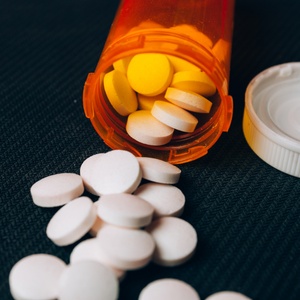Blog
Welcome to FaceForward
Get the scoop on all things beauty, wellness, and skincare.

Spironolactone (brand name Aldactone) is on the World Health Organization's List of Essential Medicines and one of the most commonly prescribed drugs in the U.S.
An androgen/aldosterone receptor antagonist that reduces levels of androgens (specifically, testosterone and dihydrotestosterone) in the body, spironolactone is prescribed for men to reduce their risk of developing conditions associated with excess androgens, such as benign prostatic hyperplasia, prostate cancer, and androgenic alopecia.
Spironolactone is also sometimes prescribed to treat acne, though this use is less frequent and not in the FDA’s approved label. Still, it’s been used successfully for the treatment of acne for years under the watchful eye of experienced dermatologists..
Other health issues that spironolactone is prescribed to control but not cure include:
Pharmacological actions of spironolactone allow the body to eliminate excess fluid without lowering potassium levels. Individuals with kidney disease take spironolactone to prevent fluid build-up in the kidneys and blood vessels without removing sodium and other minerals from the body necessary for maintaining general health.
Dermatologists have known for decades that spironolactone reduces the production of sebum, an oily substance secreted by sebaceous glands found mostly on the face and scalp. Since most sebum production is regulated by testosterone and DHT, people with excess androgens tend to produce more sebum than normal.
Androgen hormones have been implicated in the emergence of moderate to severe acne in men and women. Specifically, increased blood androgen levels are directly correlated with severe nodular acne that often permanently scars the face.
Although spironolactone is not FDA-approved for acne, dermatologists often prescribe the drug as an off-label treatment for acne. The American Academy of Dermatology Association (AADA) has published research about the efficacy of spironolactone for acne:
In addition, the AADA reports that spironolactone was effective as a stand-alone treatment for acne in 82 percent of those taking the medication. Only six percent of patients decided to discontinue taking spironolactone due to the following side effects: dizziness, headaches, fatigue, increased urination, and disruption to the menstrual cycle.
A 2021NIH-funded study investigating the long-term effects of spironolactone for acne in women found that the medication did not cause side effects troublesome enough to warrant discontinuation.
Over 400 women who took spironolactone between 2008 and 2019 participated in this longitudinal study, with 75 to 80 percent of the women reporting a significant reduction or complete elimination of back, chest, and face acne. Researchers noted that women taking an oral contraceptive while taking spironolactone experienced little to no menstrual side effects compared to women who were not taking oral contraceptives.
Doctors do not typically prescribe spironolactone for male acne because androgen/aldosterone receptor antagonists cause loss of libido, gynecomastia (male breast enlargement), and in some cases, erectile dysfunction. Consequently, severe male acne is usually treated with retinoids, prescription salicylic acid or benzoyl peroxide, or isotretinoin when acne does not respond to topical medications or oral antibiotics.
Although the AADA supports the use of spironolactone for treatment-resistant acne, studies showing the effectiveness of spironolactone are too few in number and lack certain study perimeters necessary for full FDA approval.
Although rates of mild to moderate acne are higher in women than men, the effectiveness of spironolactone for treating acne has led to the development of topical spironolactone.
Researchers began conducting clinical trials on a topical formulation in 2021 to determine if a cream containing five percent spironolactone would successfully reduce acne breakouts without causing the same side effects that affect men.
Results of the trial include:
Depending on the severity and frequency of a person's acne outbreaks, dermatologists generally prescribe 50mg to 100mg per day of spironolactone. In some cases, a dermatologist may start at a lower dose and gradually increase the dosage over several weeks.
Most patients start seeing their acne diminish after 10 to 12 weeks of taking spironolactone.
Common side effects reported by women using spironolactone for acne include:
Healthy women should have their blood pressure checked once a month to monitor any changes. Women over 40 taking spironolactone may need to have their blood potassium levels regularly evaluated as well, especially if they have borderline or high potassium. A condition called hyperkalemia (high potassium) rarely occurs while using spironolactone but can happen in some women with certain health issues. Signs of hyperkalemia involve abdominal pain, tingling or numbness of the feet, lips, or hands, and irregular heartbeat.
More serious side effects of spironolactone are typically due to the diuretic properties of the medication that could lead to dehydration and electrolyte imbalance. The following spironolactone side effects should be assessed by a physician as soon as possible:
Individuals with existing hyperkalemia, severe kidney disease, Addison's disease, immunological disorders, and certain neurological disorders should not take spironolactone.
Because spironolactone is only available for acne off-label, you’ll need a dermatologist to help decide if it’s right for you. It’s clear that because of spironolactone’s hormonal effects it’s probably not right for most men, but women with severe acne might consider a prescription under the guidance of an experienced professional.
If you’re ready to try a custom prescription for acne, Nava MD can help. With an online consultation process, we help men and women get prescription acne treatments from home if appropriate. It’s affordable, it’s all shipped to your door, and your doctor is only a message away.
This article is intended for informational purposes only and should not be considered medical advice.
Consult a healthcare professional or call a doctor in the case of a medical emergency